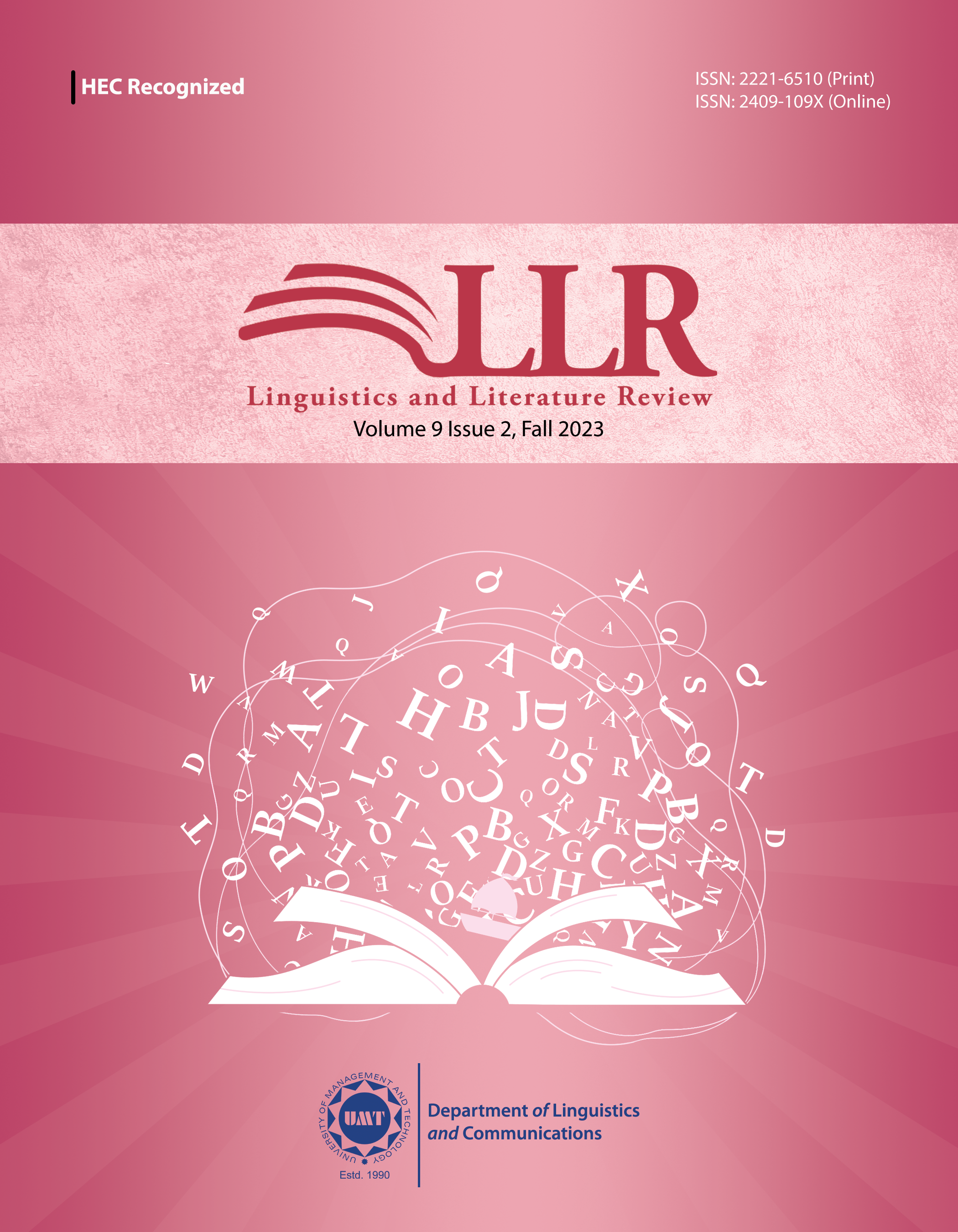An Orthographic Analysis of Sound Changing Rules in the Urdu Language
Abstract
 Abstract Views: 0
Abstract Views: 0
The current study aims to determine the sound-changing rules in the Urdu language and their underlying causes. For this purpose, words that exhibited distinct pronunciations as compared to their written forms were selected for the study. A list of 500 words was prepared from the Urdu dictionary "Feeroz-ul-Lughat," and twenty (20) proficient Urdu language speakers were selected to articulate these chosen words. The study’s analysis was divided into three stages, namely recording, transcribing, and examining the speakers' pronunciations to identify the sound changing patterns; consulting the dictionary for standard transcriptions; and phonetically and orthographically transcribing and examining the selected words. The findings revealed various contextual occurrences in which phonological changes had occurred. Additionally, after a thorough examination, the evidence supporting or contradicting the existing sound-changing rules was explored through the selected words from the Urdu language. Markedly, this study aims to enhance the understanding of the phonological dynamics in spoken Urdu expressions as well as the major factors contributing to sound changes in the Urdu language.
Downloads
References
Alderete, J. (1997). Dissimilation as local conjunction. Proceedings of North East Linguistics Society, 27(1), 17–32.
Baloch, H., Syed, N. A., & Hasan, G. (2017). Metathesis in Balochi. Dialogue, 12(1), 96–106.
Chomsky, N., & Halle, M. (1968). The sound pattern of English. Harper & Row Publishers.
Clark, J., & Yallop, C. (1990). An introduction to phonetics & phonology. Basil Blackwell.
Cole, J., & Hualde, J. I. (2011). Underlying representations. In M. van Oostendorp (Ed.), The Blackwell companion to Phonology (1–26). Wiley Publishers.
Farooq, M., & Mumtaz, B. (2016). Urdu phonological rules in connected speech. Language & Technology, 4(1), 15–23.
Farukh, A., & Vulchanova, M. (2014). Predictors of reading in Urdu: does deep orthography have an impact? Dyslexia, 20(2), 146–166. https://doi.org/10.1002/dys.1474
Fromkin, V. A. (2000). Linguistics: An introduction to linguistic theory. Blackwell Publishers.
Hawkins, E. W. (1984). Awareness of language: An introduction. Cambridge University Press.
Hulst, V. H. (1979). Rule conversion in phonology. Dutch Lexicological Institute Leiden. 14(1), 336–349. https://doi.org/10.1515/ 9783110860023-027
Hussain, S. (1997). Phonetic correlates of lexical stress in Urdu (Publication No. 9814230) [Doctoral dissertation, Northwestern University]. ProQuest Dissertations Publishing. https://tinyurl.com/yc397was
Hussain, S. (2004). Letter-to-sound conversion for Urdu text-to-speech system [Paper presentation]. Workshop on Computational Approaches to Arabic Script-Based Languages, United States.
Hussain, S. (2005). Phonological processing for Urdu text to speech system. Center for Research in Urdu Language Processing, NUCES. https://tinyurl.com/ezsv8vef
Hussain, S., & Afzal, M. (2001, December 30–30). Urdu computing standards: Urdu zabta takhti (uzt) 1.01 (Paper presentation). IEEE International Multi Topic Conference, 2001. IEEE INMIC 2001. Technology for the 21st Century, Lahore, Pakistan. https://doi.org/10.1109/INMIC.2001.995341
Jakobson, R. (1929). Remarks on the phonological evolution of Russian compared to that of other Slavic languages. Unity of Czechoslovak Mathematicians and Physicists.
Jensen, J. T. (2004). "Distinctive features," in principles of generative phonology. John Benjamins Publishing Company.
John, O. J. (1980). The application of phonological universals in speech pathology. Phonology laboratory. University of California Press.
Kachru, Y. (1990). Hindi-Urdu. In B. Comrie (Ed.), The major languages of South Asia, the Middle East and Africa. Routledge.
Khan, M. A. (1997). Urdu ka soti nizaam. Center for Research in Urdu Language Processing, NUCES.
Kiani, Z., Khan, A. Q., & Bukhari, N. H. (2011). Bilabial assimilation in Urdu: An acoustic analysis. Language in India, 11(4), 173–185.
Lehmann, J., Schmidt. S. M., & Steck, J. (1992). Strong competitive inhibition of porcine pancreaticalpha-amylase by amino-deoxy derivatives of maltose and malt-triose. Carbohydrate Research, 237, 177–183. https://doi.org/10.1016/S0008-6215(92)84241-J
Mattingly, I. G. (1972). Reading, the linguistic process, and linguistic awareness. In J. F. Kavanagh & I. G. Mattingly (Eds.), Language by ear and by eye: The relationship between speech and reading (pp. 125–126). Massachusetts Inst. of Technology.
Napoli, D. J. (1996). Linguistic: An introduction. Oxford University Press.
Odden, D. (2005). Feature theory: Introducing phonology. Cambridge University Press.
Okum, B. (2015, December 15). Level of representations. Linguistics Networks. https://www.linguisticsnetwork.com/levels-of-representation/
Panevov, J., & Hana, J. (2010). Intro to linguistics phonology. University of California.
Perre, L., & Ziegler, J. C. (2008). On-line activation of orthography in spoken word recognition. Brain Research, 1188, 132–138. https://doi.org/10.1016/j.brainres.2007.10.084
Rao, C., Vaid, J., Srinivasan, N., & Chen, H.-C. (2010). Orthographic characteristics speed Hindi word naming but slow Urdu naming: evidence from Hindi/Urdu bi-literates. Reading and Writing, 24, 679–695. https://doi.org/10.1007/s11145-010-9256-9
Roach, P. (1992). Introducing phonetics. Penguin Group.
Saleem, A. M. (2002). Assimilation rules in Urdu. Center for Research in Urdu Language Processing, 139(1), 207–219.
Schmidt, R. L. (2003). Urdu. In G. Cardona, & D. Jain (Eds.), The Indo-Aryan languages. (pp. 286–350). Routledge.
Schmitz, S. (2006). The relationship between phonology and orthography and the issue of orthographic reform for English. Grin Verlag.
Taft, M. (2001). Processing of orthographic structure by adults of different reading ability. Language and Speech, 44, 351–376. https://doi.org/10.1177/00238309010440030301
Wali, A. (2003). The rules governing the writing-pronunciation contrast in Urdu: A phonological study. Center for Research in Urdu Language Processing, 16(1), 15–23.
Waqar, A., & Waqar, S. (2002). Identification of diphthongs in Urdu and their acoustic properties. Center for Language Engineering, 14(2), 16–25.
Zia, A. (2002). Assimilation and dissimilation rules in Urdu. Dokumen. https://dokumen.tips/documents/assimilation-and-dissimilation-rules-in-urdu.html?page=1

This work is licensed under a Creative Commons Attribution 4.0 International License. Authors retain copyright and grant the journal right of first publication with the work simultaneously licensed under a Creative Commons Attribution (CC-BY) 4.0 License that allows others to share the work with an acknowledgment of the work’s authorship and initial publication in this journal.







